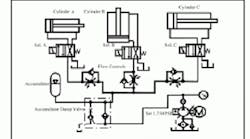If you've read The Hydraulic Troubleshooting Handbook, you'll recall that I define hydraulic troubleshooting as a logical process of elimination which begins with checking the easy things first.
The emphasis I put on investigating the easy things first may seem so elementary your inclination may be to disregard this advice. Certainly, if you DO follow a logical process of elimination, you will get a result - regardless of whether you check the easy things first or not. It's just that if you leave anything that's easy to check until last - you'll kick yourself for not giving it your attention in the beginning.
A troubleshooting situation I was involved in recently illustrates this to a tee. If you're skilled in reading hydraulic schematics and wish to follow along, the circuit is here [Hint: hover over the link and right-click to open it in a new window]. But even if you're not fluent in schematics, read on - because it's the moral of the story that's important.
The machine in question is a fairground ride. You know the ones. Its designers seem to have one objective in mind - to get you to regurgitate the contents of your stomach. And I am talking from experience.
When the passengers are strapped in, the boom of the ride is elevated by two lift cylinders (not numbered) top left of the schematic. Once elevated, hydraulic cylinder (58) retracts to remove a locking pin and the passenger carriage is rotated by motor (38).
The main hydraulic pumps are electrically powered. In case of electricity failure or main pump failure, pump (74) powered by an internal combustion engine is used to recover the ride and unload the passengers.
Prior to me receiving the call, there had been a power failure. When pump (74) was used to rotate the carriage to the locking position, rotation was found to be slow and when the carriage went over center - due to the boom not being absolutely vertical when raised - the carriage 'ran away'.
Analysis of the schematic revealed the over-running of the carriage was due to operator error. Load control valve (29) operates in one direction only - the direction of normal rotation. If the operator rotates the carriage in the opposite direction during recovery, over-run is possible.
To prove this, I elevated the boom and rotated the carriage a full revolution in the correct direction using pump (74) and DCV (75). No over-run occurred. Conversely, over-run did occur, as expected, in the opposite direction.
As an aside, it is not practical to prevent this problem by restricting DCV (75) to two positions. Because bi-directional rotation is desirable during recovery for precise positioning of the carriage for locking-pin engagement. But I did propose an alternative solution.
While rotating the carriage using pump (74), I observed rotation speed was indeed painfully slow. But there were no noticeable rotation speed issues during normal operation. While there's a number of possible points at which flow could be escaping from this circuit, most of them are common to both normal and emergency operation situations.
This focused my attention on the components that aren't common to both situations: pump (74), check valve (22) - on pump (17) and DCV (75) - which although not drawn as such, is mono-block type with integral relief valve.
Suspecting pump (74) was the culprit, I flow tested it at connection P1. It tested OK. I then connected the flow meter across the service ports of DCV (75). Again, OK. This also eliminated relief valve (44), unloading valve (47), ball valve (77) and check valve (22) on pump (17).
So continuing the logical process of elimination - what next? Looking again at the rotation manifold (circled on the drawing) - which is 30 feet in the air when the ride is operating - I cussed aloud at myself. With the ride in its parking position, I walked over to this manifold and sure enough, I got nearly two turns out of needle valve (37) in a clockwise direction.
Other than the heat load, the amount of flow passing across this needle valve wasn't an issue during normal operation - due to the amount of flow available from the main pump. But it was very noticeable when using the much smaller flow available from the emergency pump.
With the benefit of hindsight, needle valve (37) was the easiest and therefore the FIRST thing I should have checked. Oh sure, my logical process of elimination was always going to lead me to it. But had I checked it in the beginning - it would have been a five minute troubleshooting exercise instead of two hours!
As this example demonstrates, not checking the easy things first when troubleshooting can be a costly mistake. And to discover six other costly mistakes you want to be sure to avoid with your hydraulic equipment, get "Six Costly Mistakes Most Hydraulics Users Make... And How You Can Avoid Them!" available for FREE download here.
Sponsored Recommendations
May 15, 2024
March 13, 2024
March 13, 2024
March 13, 2024

